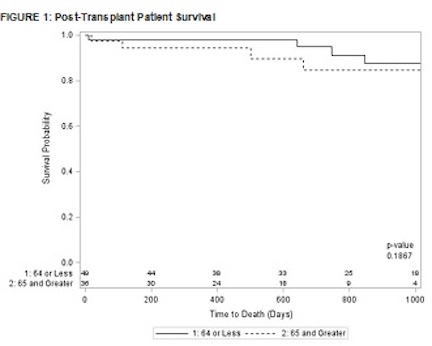Evaluation of Survival and Maintenance Immunosuppression in Elderly Lung Transplant Recipients
1Spectrum Health, Grand Rapids, MI
2Michigan State University College of Human Medicine, Grand Rapids, MI.
Meeting: 2018 American Transplant Congress
Abstract number: C265
Keywords: Elderly patients, Immunosuppression, Lung transplantation
Session Information
Session Name: Poster Session C: Lung: All Topics
Session Type: Poster Session
Date: Monday, June 4, 2018
Session Time: 6:00pm-7:00pm
 Presentation Time: 6:00pm-7:00pm
Presentation Time: 6:00pm-7:00pm
Location: Hall 4EF
Background: Lung transplantation in the elderly is controversial given increased risks and the optimal immunosuppression regimen is not fully understood.
Methods: A retrospective cohort study was conducted in 85 adult patients that underwent lung transplant from Feb 2013 to Aug 2017. Patients were stratified based on age:<65 years (Grp 1, n=49) vs ≥65 years (Grp 2, n=36). The impact of age on survival, maintenance immunosuppression differences, and post-transplant outcomes were evaluated.
Results: More patients in Grp 2 had IIP and received a single lung transplant (Table 1). There was no difference in survival with 699 ± 626 days follow-up (Figure 1). More patients in Grp 2 had rejection grade A2 or greater at 1 year, although not statistically significant (50% vs 30%, p=0.1096). The majority of patients were on a standard maintenance regimen (tacrolimus [TAC], mycophenolate mofetil [MMF], and prednisone [PRED]) at discharge (Grp 1: 89.6% vs Grp 2: 82.4%, p=0.3053); this decreased in both groups by 1 year (Grp 1: 51.3% vs Grp 2: 58.3%, p=0.5855). The most common non-standard regimen at 1 year was TAC/PRED (Grp 1: 23.1% vs Grp 2: 29.2%). MMF daily dosing <2000mg was less frequent at discharge (Grp 1: 13.3% vs Grp 2: 18.8%, p=0.5404) but increased by 1 year to 42.9% in both groups. Grp 2 received lower daily TAC doses at discharge (0.025 ± 0.034 vs 0.061 ± 0.063 mg/kg, p=0.0003) but had similar mean trough levels (Grp 2: 9.8 ± 3.6 vs Grp 1: 9.5 ± 2.7 ng/mL, p=0.6524).
Conclusion: Elderly patients have comparable survival after lung transplantation with intermediate follow-up. Maintenance immunosuppression was frequently changed from discharge to 1 year. MMF dose reduction was common. Elderly patients obtain similar TAC troughs despite lower doses.
CITATION INFORMATION: Nguyen P., Girgis R., Murphy E., Hadley R., Leacche M., Kumar A., Sathiyamoorthy G., McDermott J. Evaluation of Survival and Maintenance Immunosuppression in Elderly Lung Transplant Recipients Am J Transplant. 2017;17 (suppl 3).
To cite this abstract in AMA style:
Nguyen P, Girgis R, Murphy E, Hadley R, Leacche M, Kumar A, Sathiyamoorthy G, McDermott J. Evaluation of Survival and Maintenance Immunosuppression in Elderly Lung Transplant Recipients [abstract]. https://atcmeetingabstracts.com/abstract/evaluation-of-survival-and-maintenance-immunosuppression-in-elderly-lung-transplant-recipients/. Accessed December 15, 2025.« Back to 2018 American Transplant Congress


